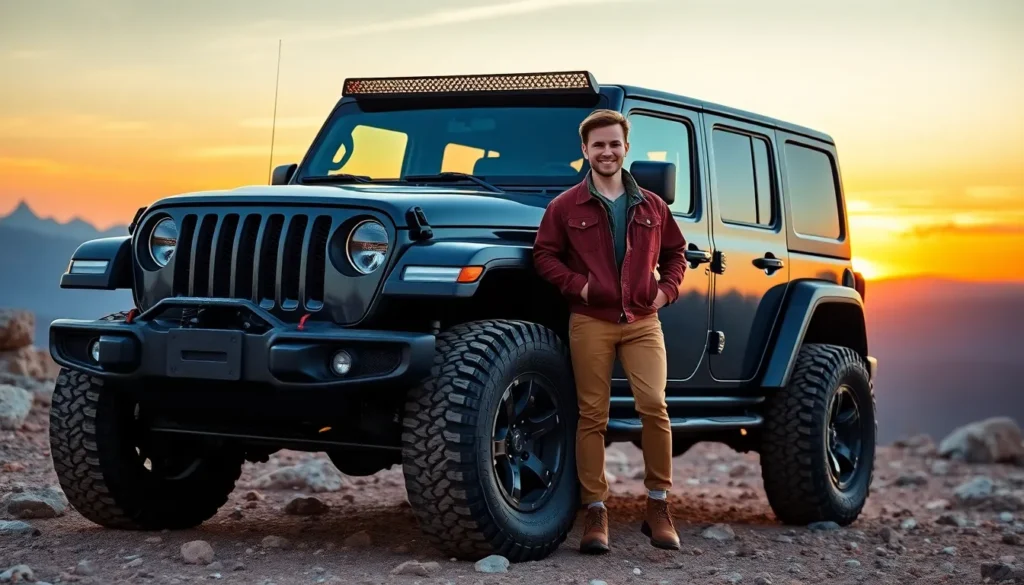The Jeep Wrangler isn’t just another SUV – it’s a rolling statement that screams adventure and individuality. We’ve all seen them cruising down highways with their doors off and tops down, turning heads wherever they go. There’s something undeniably magnetic about that rugged, boxy silhouette that makes us stop and stare.
What sets the Wrangler apart isn’t just its legendary off-road capability; it’s the distinctive aesthetic that’s remained virtually unchanged for decades. From the iconic seven-slot grille to those round headlights that seem to wink at oncoming traffic, every design element tells a story of freedom and rebellion against the ordinary.
Whether you’re drawn to the classic military-inspired look or prefer modern customizations that push boundaries, the Wrangler’s aesthetic offers endless possibilities. We’re diving deep into what makes this vehicle’s design so compelling and how you can make it uniquely yours.
What Makes the Jeep Wrangler Aesthetic So Iconic
The seven-slot grille stands as the most recognizable design element of the Wrangler’s aesthetic legacy. This distinctive feature traces back to 1941 when Willys-Overland first introduced it on military vehicles during Industry War II. Round headlights complement the grille design with their classic circular shape that maintains visual consistency across all model years.
Bold proportions define the Wrangler’s commanding road presence through its upright stance and geometric body lines. The vehicle’s rectangular windshield creates an unmistakable silhouette that distinguishes it from curved designs found on modern SUVs. Exposed door hinges and visible body hardware reinforce the utilitarian character that enthusiasts associate with authentic off-road capability.
Removable components transform the Wrangler aesthetic from enclosed SUV to open-air adventure vehicle. The soft or hard top removal system allows owners to experience different visual configurations throughout the year. Detachable doors provide additional customization options that enhance the rugged outdoor appearance.
| Design Element | Introduction Year | Cultural Impact |
|---|---|---|
| Seven-slot grille | 1941 | Military heritage symbol |
| Round headlights | 1941 | Timeless recognition factor |
| Removable doors | 1976 | Freedom expression |
| Fold-down windshield | 1945 | Adventure functionality |
Color options amplify the Wrangler’s aesthetic versatility across different owner preferences. Bright colors like Hellayella and Firecracker Red create bold statements that emphasize the vehicle’s adventurous personality. Earth tones such as Sarge Green and Granite Crystal maintain connection to the original military roots while appealing to traditional buyers.
Functional design elements serve dual purposes as both practical features and aesthetic enhancements. The spare tire mounted on the rear tailgate creates a distinctive rear profile that signals off-road readiness. Rock rails protect the vehicle’s undercarriage while adding visual weight to the lower body sections.
These iconic elements combine to create an aesthetic that transcends typical automotive design trends. The Wrangler’s visual identity remains instantly recognizable whether parked in urban environments or handling remote trails.
Classic Design Elements That Define the Wrangler Look

Classic design elements create the foundation of Wrangler aesthetic appeal that transcends generations. These timeless features establish instant recognition and maintain the vehicle’s authentic character across decades of evolution.
The Seven-Slot Grille Legacy
The seven-slot grille represents the most recognizable Wrangler design element since Willys-Overland introduced it in 1941. This distinctive feature originated from military specifications requiring adequate airflow for cooling systems during combat operations. Each vertical slot maintains precise spacing that balances functional airflow with visual symmetry.
Modern Wrangler models preserve the original seven-slot configuration while incorporating contemporary materials like aluminum and high-strength plastics. The grille’s prominence creates immediate brand identification from distances exceeding 100 yards. Bold chrome accents on premium trims enhance the slots’ visual impact without compromising the utilitarian foundation.
Paint-matched grille options allow owners to customize appearance while maintaining the classic proportions. The seven-slot design influences aftermarket modifications including mesh inserts, LED light integration, and colored accent pieces that respect the original geometry.
Round Headlights and Their Timeless Appeal
Round headlights establish the Wrangler’s friendly yet purposeful front-end character through their classic proportions. These circular lenses originated from military vehicle requirements for maximum illumination coverage in challenging terrain conditions. Standard 7-inch diameter headlights provide optimal light distribution patterns for both on-road visibility and off-road navigation.
LED headlight conversions maintain the round aesthetic while delivering 3x brighter illumination than traditional halogen units. The circular shape creates visual harmony with the seven-slot grille above and complements the vehicle’s overall geometric design language. Aftermarket options include RGB halo rings that add customizable accent lighting without altering the fundamental round profile.
Protective headlight guards preserve the classic round appearance while adding functional durability for trail adventures. The positioning of round headlights creates the Wrangler’s distinctive “face” that remains instantly recognizable across generations of design evolution.
Boxy Body Shape and Rugged Proportions
Boxy body shape defines the Wrangler’s utilitarian aesthetic through straight lines and angular surfaces that maximize interior space. These geometric proportions originated from military design requirements emphasizing functionality over aerodynamic efficiency. Vertical windshield angles create commanding visibility while maintaining the characteristic upright stance.
Flat body panels reduce manufacturing complexity and simplify aftermarket customization compared to curved automotive designs. The rectangular door frames accommodate removable door systems that enhance open-air driving experiences. Short front and rear overhangs optimize approach and departure angles for off-road obstacle navigation.
Ground clearance measurements ranging from 8.7 to 10.9 inches depending on trim level contribute to the vehicle’s tall proportions. Wide fender flares accommodate larger tire sizes while maintaining the boxy silhouette that defines Wrangler aesthetics. These rugged proportions create visual weight that conveys capability and durability through purposeful design geometry.
Interior Aesthetic Features and Design Philosophy
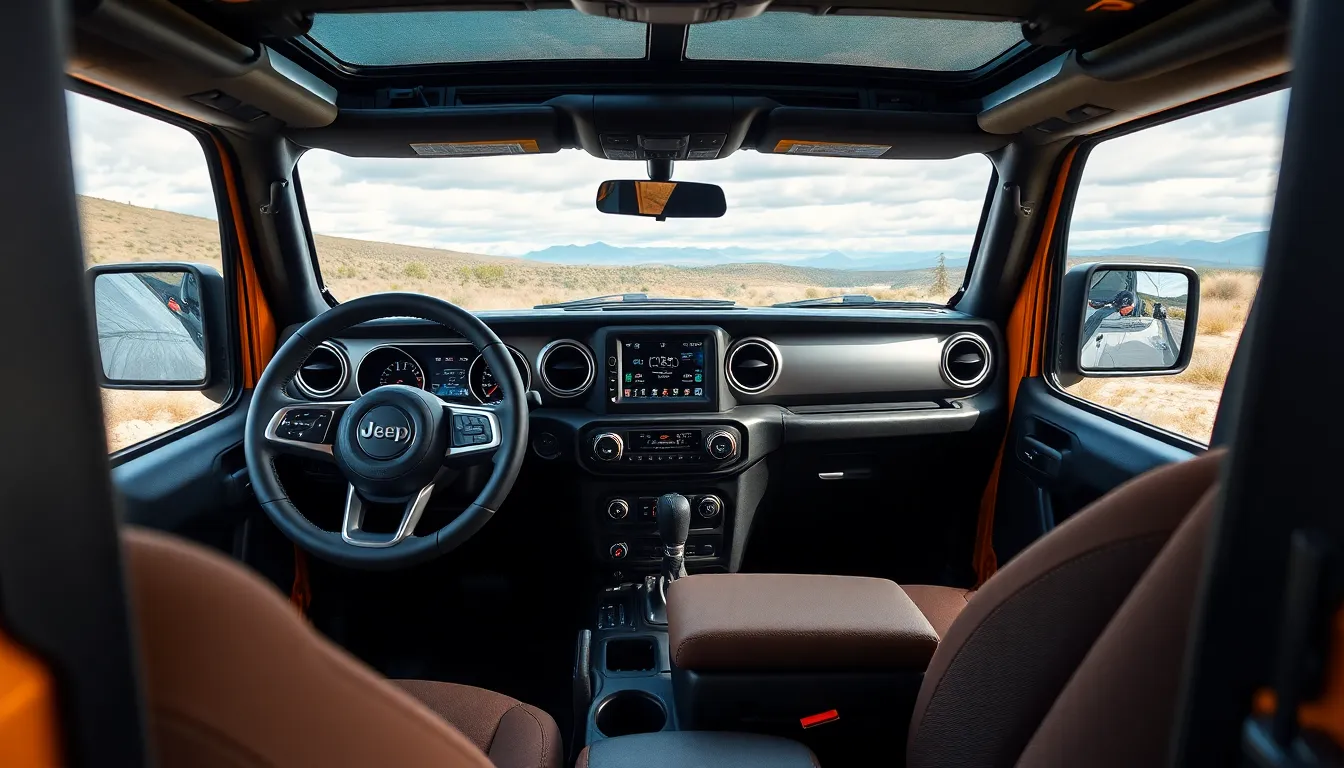
Interior aesthetic features inside the Jeep Wrangler embrace the same rugged design philosophy that defines its exterior appearance. Functional elements take priority over luxury appointments while maintaining a distinctive character that reinforces the vehicle’s adventure ready identity.
Dashboard and Control Layout
Dashboard design in the Wrangler reflects the vehicle’s utilitarian heritage through bold geometric shapes and clearly defined control zones. Central air vents adopt circular forms that echo the exterior headlight design while maintaining optimal airflow distribution. Physical buttons and knobs dominate the control layout rather than touch sensitive surfaces that can malfunction in dusty or wet conditions.
Instrument cluster placement positions critical gauges like oil pressure and coolant temperature in easy view locations for off road monitoring. Metal trim pieces accent key areas of the dashboard using materials like gunmetal gray or bright silver finishes. Storage compartments integrate seamlessly into the dashboard design with rubber lined bins that contain loose items during rough terrain driving.
Control switches feature robust construction with positive feedback mechanisms that operators can engage while wearing gloves. Grab handles mount directly into the dashboard structure at passenger locations to provide secure hand holds during steep inclines or side angle traverses.
Seating Materials and Color Options
Seating materials in Wrangler models balance durability requirements with comfort considerations across multiple trim levels. Cloth upholstery options include water resistant treatments that repel moisture and resist staining from outdoor activities. Premium leather appointments feature grain patterns and protective coatings designed for easy cleaning after exposure to mud or sand.
Color combinations typically center around earth tone palettes that complement the vehicle’s outdoor focused aesthetic. Black remains the most popular interior color choice with contrasting stitching available in accent colors like red, orange, or yellow. Light colored options such as tan or gray provide visual contrast in darker exterior paint combinations while showing dirt less readily than pure white alternatives.
Seat designs incorporate bolstering elements that secure occupants during off road maneuvers without restricting entry and exit movements. Removable seat covers allow owners to customize interior appearance while protecting original upholstery during particularly demanding adventures. Heating elements integrate into front seats on equipped models using low profile wiring that maintains the clean aesthetic lines of the seating surfaces.
Exterior Customization Options for Enhanced Appeal
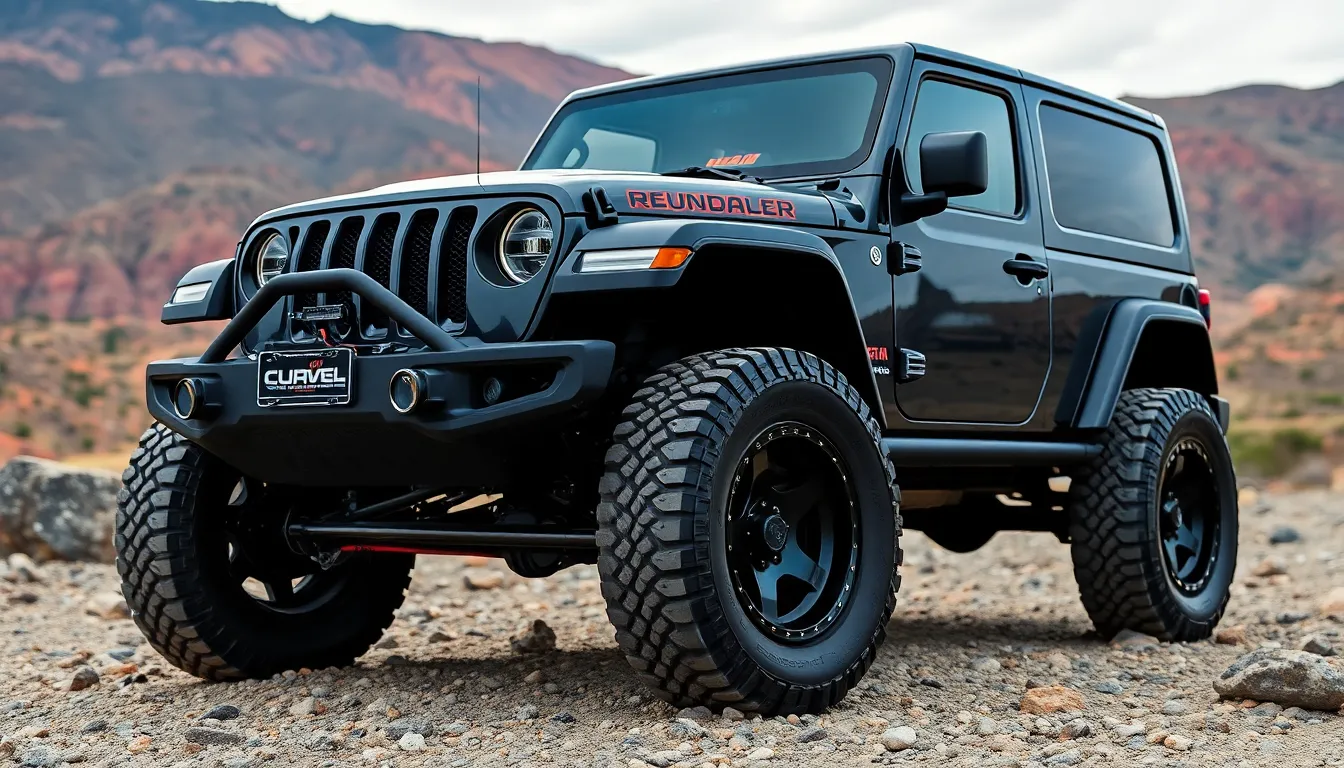
Exterior customization transforms the Jeep Wrangler aesthetic from stock appearance into a personalized statement piece. These modifications enhance both visual impact and functional performance while maintaining the vehicle’s iconic design DNA.
Lift Kits and Wheel Upgrades
Lift kits elevate the Wrangler’s stance by 2 to 6 inches above factory height. Body lifts cost between $200 and $800 and provide clearance for larger tires without affecting suspension geometry. Suspension lifts range from $1,500 to $4,000 and improve ground clearance while improving approach and departure angles for serious off-road performance.
Wheel upgrades complement lifted suspensions with sizes typically ranging from 17 to 20 inches in diameter. Beadlock wheels secure tire beads during low-pressure off-road driving and add aggressive styling elements. Popular finishes include matte black, bronze, and machined aluminum that emphasize the rugged Wrangler aesthetic.
Tire combinations with lift kits create dramatic visual impact through increased sidewall height. Common sizes include 35-inch tires on 3-inch lifts and 37-inch tires on 4-inch or higher lifts. All-terrain tread patterns enhance the adventurous appearance while maintaining street manners.
Bumpers and Protective Accessories
Aftermarket bumpers replace factory plastic components with steel or aluminum construction. Front bumpers integrate winch mounts, D-ring recovery points, and LED light provisions. Prices range from $400 for basic tube bumpers to $2,000 for full-width modular systems with integrated features.
Rock sliders protect the Wrangler’s body panels during trail obstacles. These tubular steel guards mount to the frame and extend beneath the doors. Rocker panel protection prevents costly body damage while adding to the vehicle’s tactical appearance.
Fender flares accommodate larger tire sizes while maintaining legal coverage requirements. Factory Rubicon flares provide 2 inches of additional coverage while aftermarket options extend up to 6 inches. Flat fender styles reference military Jeep heritage and create clean, minimalist lines.
Skid plates shield vulnerable undercarriage components from rock impacts. Aluminum and steel options cover the transmission, transfer case, and fuel tank. These protective elements remain largely hidden but contribute to the overall rugged capability that defines Wrangler ownership.
Lighting Modifications and Visual Impact
LED headlight upgrades replace halogen units with modern lighting technology. These conversions typically feature 7-inch round housings that preserve the classic Wrangler aesthetic while delivering 3,000 to 4,000 lumens of output. Halo accent rings and sequential turn signals add contemporary styling elements.
Light bars mount above the windshield or integrate into front bumpers. Single-row bars measure 20 to 50 inches in length and provide flood or spot beam patterns. Curved profiles follow windshield contours while maintaining aerodynamic efficiency.
Fog lights enhance low-visibility driving conditions through dedicated amber or white LED units. Pod-style lights mount in factory fog light locations or integrate into aftermarket bumper designs. These additions create symmetrical lighting arrangements that emphasize the Wrangler’s wide stance.
Rock lights illuminate the ground beneath the vehicle during nighttime off-road adventures. These compact LED strips mount under the chassis and create an underglow effect. Color options include white for functionality and blue or red for aesthetic appeal during camping or trail gatherings.
Color Options and Their Impact on Wrangler Aesthetics
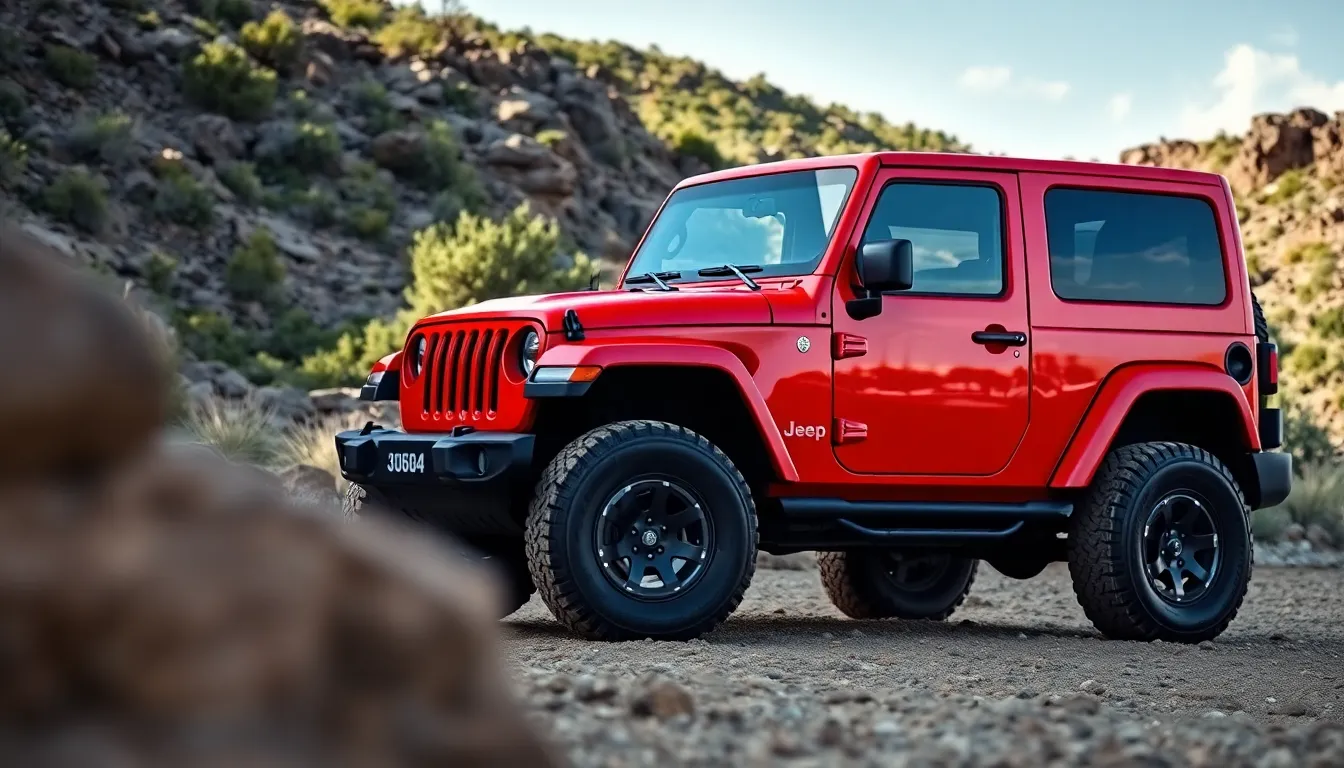
Color selection dramatically transforms our Wrangler’s visual presence on and off the road. Factory paint options span 15 distinct shades across the current model year, with each choice affecting how light interacts with the vehicle’s angular surfaces and iconic design elements.
Classic Earth Tones
Black remains the dominant choice among 32% of Wrangler buyers, offering versatility that complements any modification or accessory. Granite Crystal Metallic provides depth through its metallic flake composition, creating subtle light reflection that enhances the boxy silhouette. Olive Green Pearlcoat connects directly to the Wrangler’s military heritage, delivering authentic utility vehicle aesthetics that resonate with traditional enthusiasts.
Bold Statement Colors
Bright colors like Firecracker Red and Nacho command attention while highlighting exact design features differently. Red paint accentuates the seven-slot grille’s shadow lines, creating dramatic contrast between recessed and raised surfaces. Yellow finishes like Nacho amplify the Wrangler’s playful character, making round headlights appear more prominent against the vibrant backdrop.
Metallic and Pearl Finishes
Steel Metallic Gray offers sophisticated appeal through its multi-layered paint system containing aluminum particles. Ocean Blue Metallic shifts between deep navy and lighter blue tones depending on viewing angle, creating visual interest across flat door panels. Pearl finishes add complexity through mica particles that produce color-shifting effects under different lighting conditions.
| Popular Wrangler Colors | Market Share | Aesthetic Impact |
|---|---|---|
| Black Clearcoat | 32% | Universal compatibility with accessories |
| Bright White Clearcoat | 18% | Clean, modern appearance |
| Granite Crystal Metallic | 12% | Sophisticated depth and dimension |
| Firecracker Red | 8% | Bold, attention-grabbing presence |
| Ocean Blue Metallic | 7% | Ever-changing color-shifting effects |
Color Psychology in Design
Darker colors minimize visual bulk while lighter shades emphasize the Wrangler’s substantial proportions. White paint reflects heat more effectively, benefiting both comfort and paint longevity in extreme climates. Metallic finishes hide minor scratches and swirl marks better than solid colors, maintaining aesthetic appeal during heavy off-road use.
Accent and Two-Tone Options
Body-colored fender flares create seamless integration with certain paint choices, particularly on Sahara and Rubicon trim levels. Black fender flares provide contrast regardless of body color, emphasizing the Wrangler’s utilitarian roots. Hardtop color coordination affects overall visual flow, with matching tops creating unified aesthetics while contrasting combinations add visual interest.
Seasonal and Limited Editions
Special edition colors like Tuscadero Pink and High Velocity Yellow generate collector interest while pushing aesthetic boundaries. These limited-run options often feature unique interior accent stitching that complements the exterior finish. Anniversary editions typically showcase heritage-inspired color combinations that celebrate exact Jeep milestones.
How the Wrangler Aesthetic Compares to Other Off-Road Vehicles
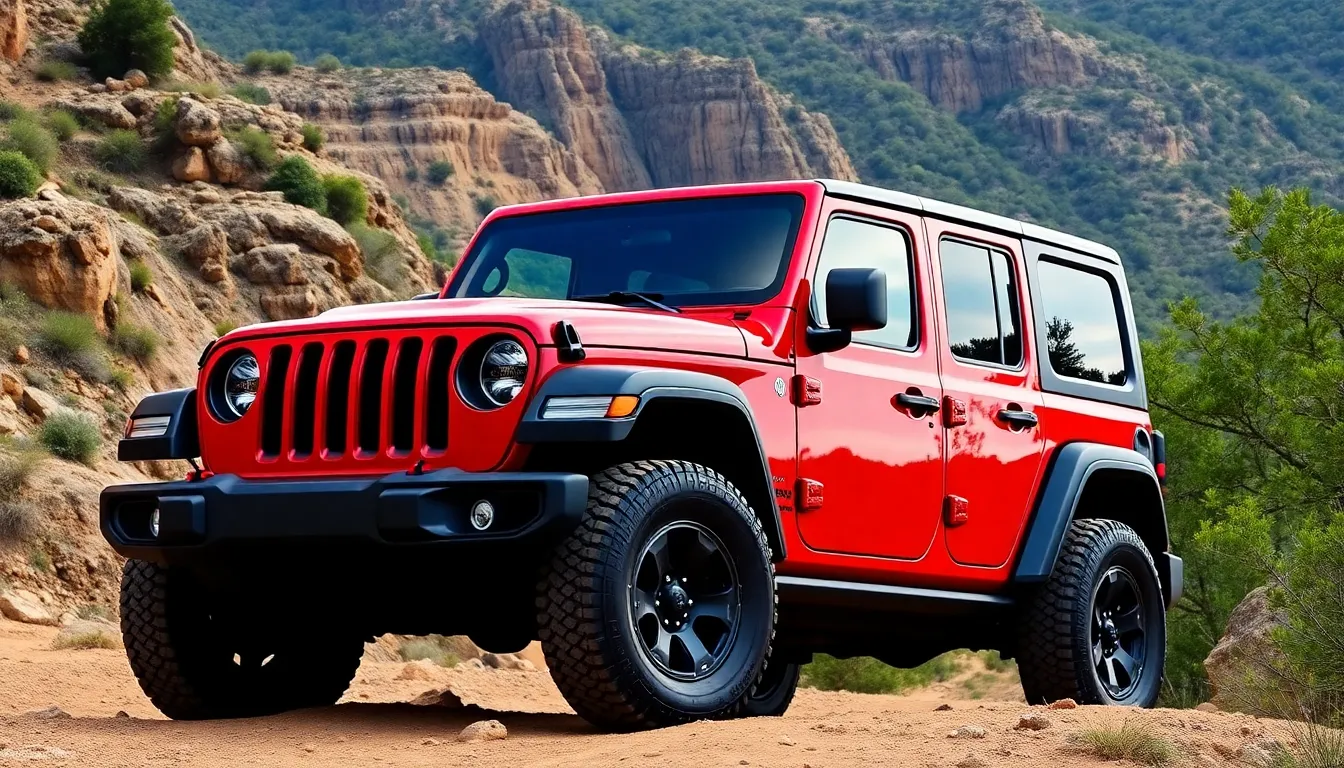
The Wrangler’s aesthetic stands apart from competitors through its distinctive combination of retro military heritage and modern functionality. Ford Bronco attempts to match this appeal with angular body panels and circular design elements, yet it lacks the seven-slot grille’s iconic recognition that dates back to 1941. Toyota 4Runner emphasizes rugged proportions through prominent wheel arches and aggressive front fascia styling, though its aesthetic leans more toward contemporary SUV design than the Wrangler’s utilitarian simplicity.
Chevrolet Tahoe Z71 features bold front grille treatment and skid plate accents that communicate off-road capability, but its aesthetic focuses on luxury integration rather than pure functional design. Land Rover Defender incorporates boxy proportions and removable panels similar to Wrangler design philosophy, creating the closest aesthetic competitor in the premium off-road segment. GMC Canyon AT4 uses distinctive red tow hooks and specialized badging to convey off-road purpose, though it maintains traditional pickup truck proportions that differ significantly from Wrangler’s compact SUV silhouette.
| Vehicle | Distinctive Feature | Aesthetic Focus | Price Range |
|---|---|---|---|
| Jeep Wrangler | Seven-slot grille | Military heritage | $35,000-$65,000 |
| Ford Bronco | Circular headlights | Retro adventure | $37,000-$70,000 |
| Toyota 4Runner | Prominent wheel arches | Rugged reliability | $40,000-$55,000 |
| Land Rover Defender | Boxy proportions | Premium utility | $55,000-$90,000 |
| Chevrolet Tahoe Z71 | Bold grille treatment | Luxury capability | $58,000-$75,000 |
Interior aesthetic comparisons reveal the Wrangler’s commitment to functional simplicity versus competitors’ luxury integration approaches. Bronco interiors feature similar removable elements and water-resistant materials, though Ford incorporates more contemporary infotainment interfaces that prioritize technology over simplicity. 4Runner cabins emphasize durability through robust plastics and straightforward control layouts, matching Wrangler’s utilitarian philosophy while adding more sound dampening materials for highway comfort.
Customization potential varies significantly across off-road vehicle segments, with Wrangler leading in aftermarket support and modification accessibility. Bronco offers factory lift packages and accessory integration points, though the aftermarket network remains smaller than Wrangler’s extensive modification network. Defender provides premium customization options through Land Rover’s Adventure Pack accessories, focusing on expedition-ready upgrades rather than the grassroots modification culture surrounding Wrangler aesthetics.
Color palette strategies among competitors reflect different brand positioning approaches within off-road aesthetics. Bronco offers heritage-inspired colors like Cactus Gray and Velocity Blue that reference Ford’s racing legacy, while Wrangler’s earth tones connect directly to military vehicle traditions. 4Runner maintains conservative color options that emphasize long-term resale value, contrasting with Wrangler’s bold seasonal colors like Firecracker Red and Nacho that celebrate individual expression over market considerations.
The Evolution of Jeep Wrangler Styling Through the Years
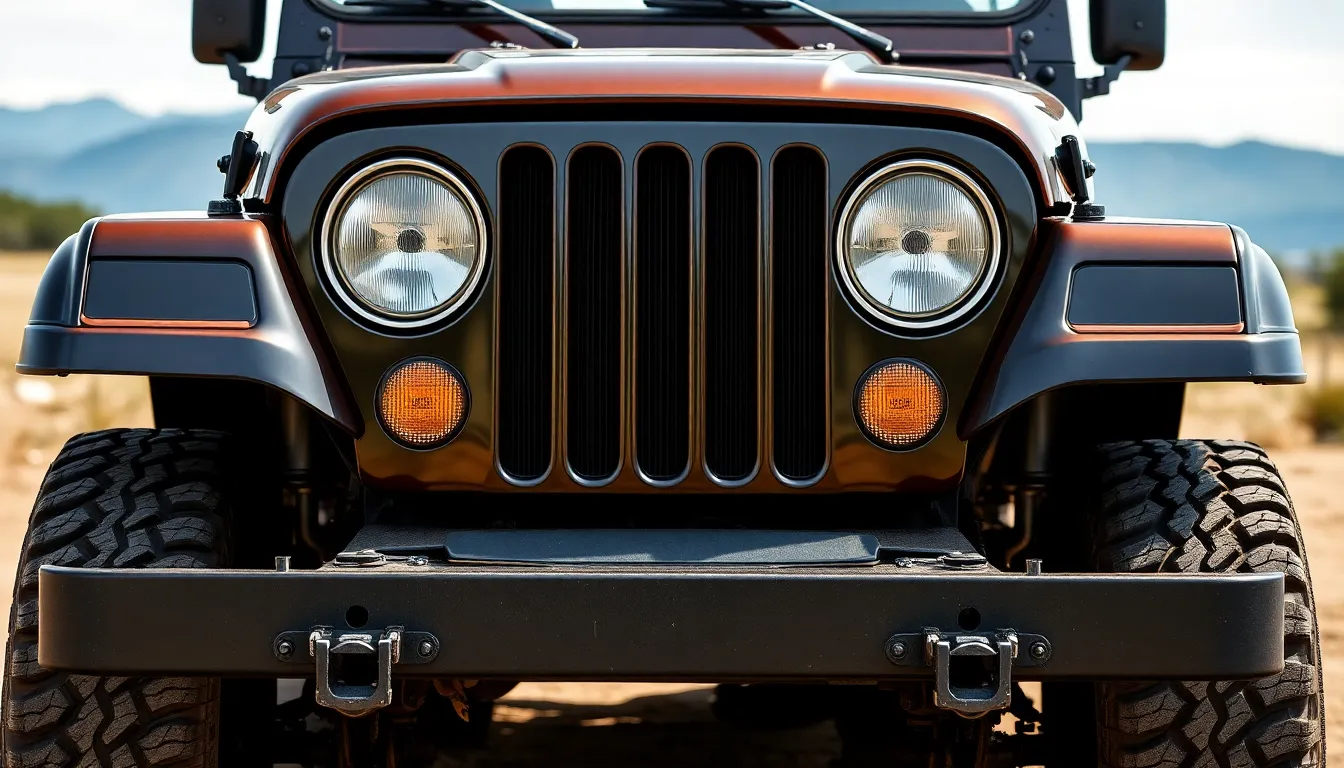
The Evolution of Jeep Wrangler styling traces back to 1987 when the first civilian Wrangler replaced the CJ series. Chrysler designed the YJ generation with square headlights, which marked the most controversial aesthetic change in Jeep history. Enthusiasts protested this departure from the traditional round headlight design that connected back to the original Willys MB.
Square headlights dominated the YJ model from 1987 to 1995, creating a more angular front fascia that aligned with 1980s automotive trends. Body cladding appeared along the lower sections, adding visual weight to the vehicle’s profile. Leaf springs remained in the rear suspension, maintaining the classic Jeep stance that owners recognized from earlier generations.
First Generation YJ Changes
Design elements reflected contemporary styling cues while preserving core Jeep characteristics. Wider fender flares accommodated larger tires and enhanced the rugged appearance. Soft top mechanisms improved with better sealing and easier operation compared to CJ models. Interior updates included more modern dashboard layouts and improved ergonomics.
Color options expanded beyond military green to include bright reds, blues, and yellows that appealed to recreational buyers. Special editions like the Islander and Sahara introduced unique graphics packages and accent colors. These modifications demonstrated how Wrangler aesthetics could adapt to consumer preferences while maintaining functional priorities.
TJ Generation Returns to Tradition
Round headlights returned in 1997 with the TJ generation, restoring the classic Jeep face that enthusiasts demanded. Coil spring suspension replaced leaf springs, creating a more refined ride quality without compromising off road capability. Fender flares adopted smoother curves that complemented the restored circular lighting elements.
Interior design evolved with more sophisticated materials and improved fit and finish. Dashboard layouts incorporated modern convenience features while preserving the utilitarian aesthetic. Color coordinated interiors matched exterior paint schemes, creating cohesive design themes across trim levels.
| Generation | Years | Key Changes | Headlight Style |
|---|---|---|---|
| YJ | 1987-1995 | Square headlights, body cladding | Square |
| TJ | 1997-2006 | Round headlights return, coil springs | Round |
| JK | 2007-2018 | Larger dimensions, safety features | Round |
| JL | 2018-present | LED lighting, aluminum panels | Round LED |
JK Era Modernization
Larger dimensions characterized the JK generation that launched in 2007 with four door Unlimited models becoming increasingly popular. Safety requirements influenced design elements including higher door frames and reinforced pillars. Modern conveniences like power windows and central locking became standard features across most trim levels.
Wheel designs grew more sophisticated with machined aluminum options replacing basic steel wheels. Interior materials upgraded significantly with soft touch surfaces and improved acoustic insulation. Technology integration expanded with navigation systems and premium audio options that previous generations lacked.
Current JL Generation Refinements
LED headlights became standard equipment in 2018, updating the classic round shape with modern lighting technology. Aluminum body panels reduced weight while maintaining structural integrity and corrosion resistance. Windshield design improved aerodynamics without compromising the fold down functionality that defines Wrangler versatility.
Interior technology reached new levels with touchscreen infotainment systems and smartphone integration. Premium materials like leather appointed seating and soft touch dashboard surfaces elevated the cabin experience. Color options expanded to include bold seasonal choices that celebrate individual expression and lifestyle preferences.
Frame construction adopted high strength steel that improved crash protection while reducing overall weight. Suspension tuning balanced on road comfort with legendary off road performance. These evolutionary changes demonstrate how Wrangler styling adapts modern requirements while preserving the iconic aesthetic elements that define the brand.
Conclusion
The Jeep Wrangler’s aesthetic remains unmatched in today’s automotive industry. We’ve seen how its timeless design elements create a perfect balance between rugged functionality and visual appeal that resonates with adventure seekers worldwide.
Whether you’re drawn to classic earth tones or bold statement colors the Wrangler offers endless possibilities for personal expression. Its design philosophy proves that authenticity and practicality can coexist beautifully.
As we look toward the future we’re confident the Wrangler will continue evolving while staying true to its iconic roots. This SUV doesn’t just transport you—it makes a statement about who you are and where you’re headed.
Frequently Asked Questions
What makes the Jeep Wrangler’s design so iconic?
The Jeep Wrangler’s iconic design centers around three key elements: the seven-slot grille dating back to 1941 military vehicles, round headlights that provide optimal illumination and a friendly appearance, and the boxy, rugged body shape that maximizes interior space while enhancing off-road capabilities. These features have remained largely unchanged, creating instant recognition and embodying the vehicle’s adventure-ready heritage.
How has Wrangler styling evolved over the generations?
Wrangler styling has evolved through four main generations: YJ (1987-1995) introduced square headlights and body cladding; TJ (1997-2006) restored round headlights and added coil springs; JK (2007-2018) increased size and added modern conveniences; and the current JL (2018-present) features LED lighting, aluminum panels, and advanced technology while preserving classic design elements.
What are the most popular Jeep Wrangler colors?
The most popular Wrangler color is black, offering timeless appeal and versatility. Factory options include classic earth tones, bold statement colors like Firecracker Red and Nacho, and metallic finishes. Seasonal and limited edition colors create collector interest, while bright colors create striking contrasts that highlight the vehicle’s design features and allow for personal expression.
What interior design features define the Wrangler’s aesthetic?
The Wrangler’s interior prioritizes functional design over luxury, featuring a utilitarian dashboard with bold geometric shapes, circular air vents that echo exterior styling, and robust controls operable with gloves. Seating materials balance durability and comfort with water-resistant cloth and easy-to-clean leather options. Earth tone color schemes, particularly black, dominate the interior palette.
How does the Wrangler compare aesthetically to other off-road vehicles?
The Wrangler stands apart from competitors like the Ford Bronco and Toyota 4Runner through its distinctive seven-slot grille, utilitarian simplicity, and retro military heritage combined with modern functionality. While other vehicles offer rugged designs, none match the Wrangler’s iconic styling elements, superior aftermarket customization support, or bold color palette celebrating individual expression.
What are the best exterior modifications for Wrangler aesthetics?
Popular exterior modifications include lift kits for elevated stance and improved off-road performance, wheel upgrades that complement lifts, aftermarket bumpers for enhanced protection and style, and lighting modifications like LED headlights and light bars. These modifications enhance both functionality and visual appeal while maintaining the classic Wrangler aesthetic and allowing for personal customization.

